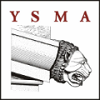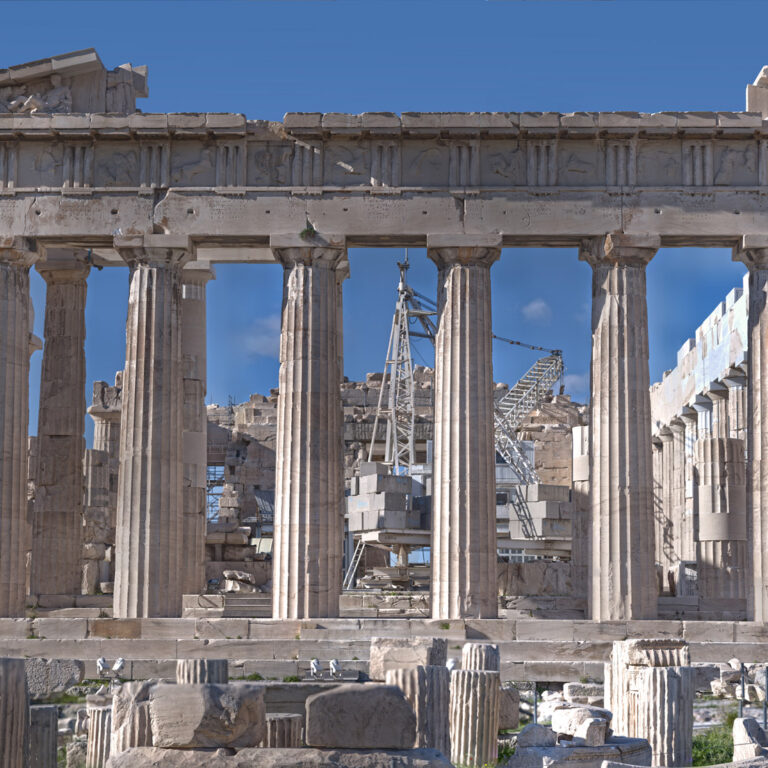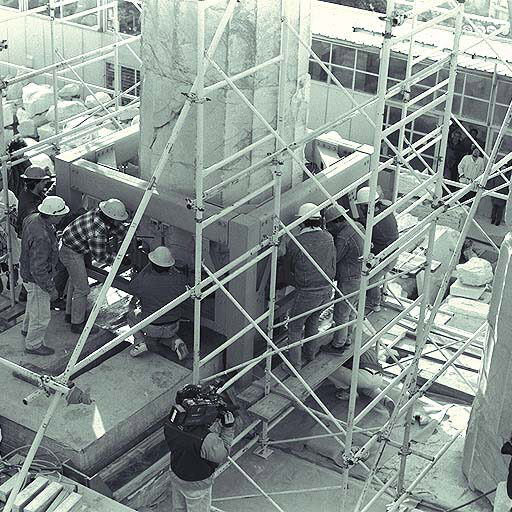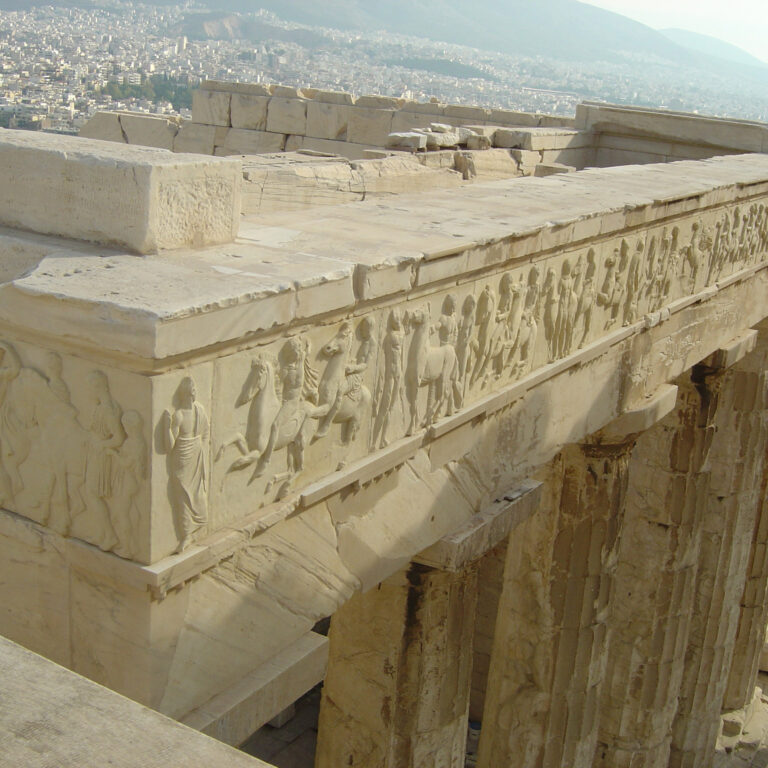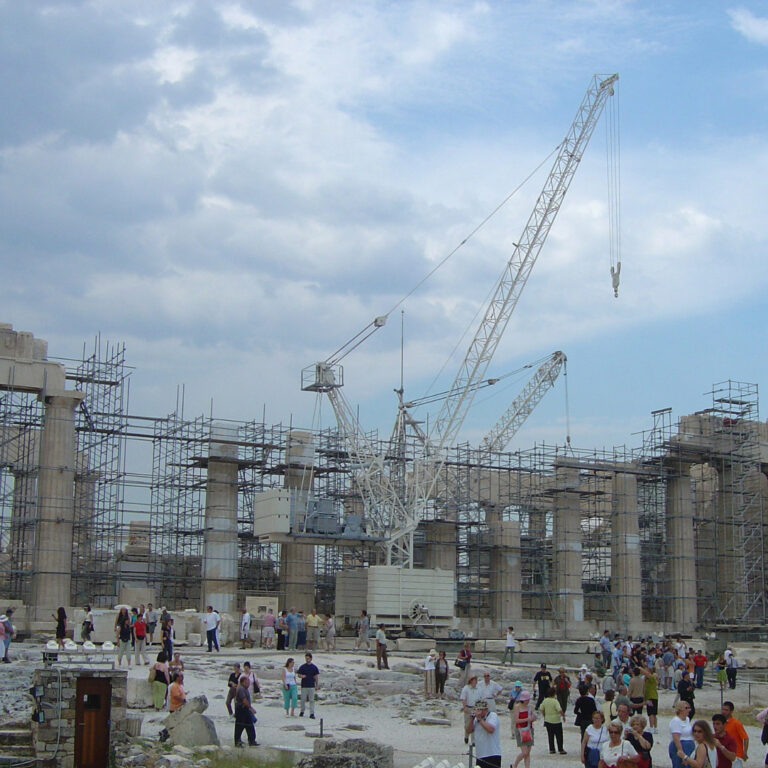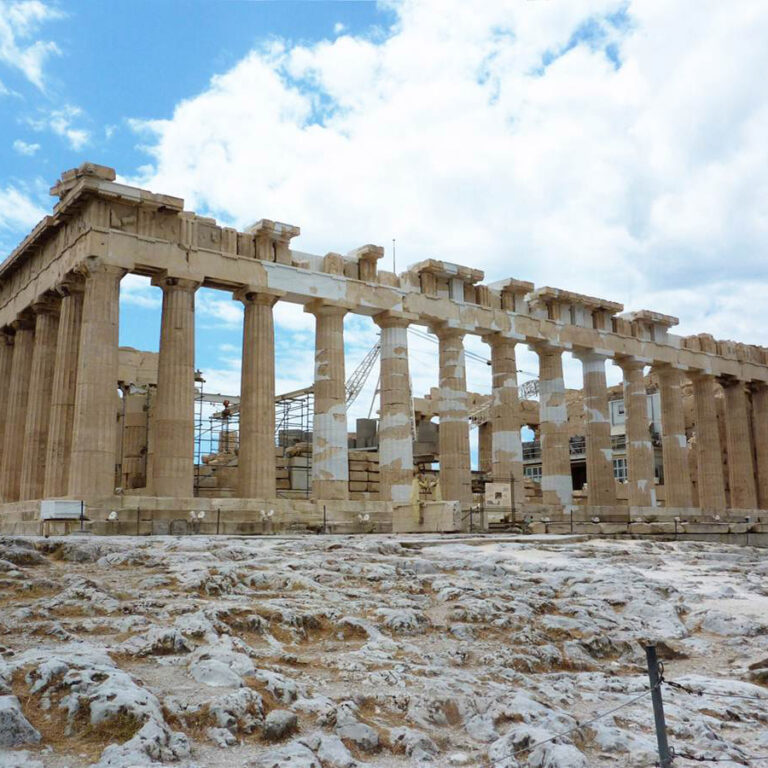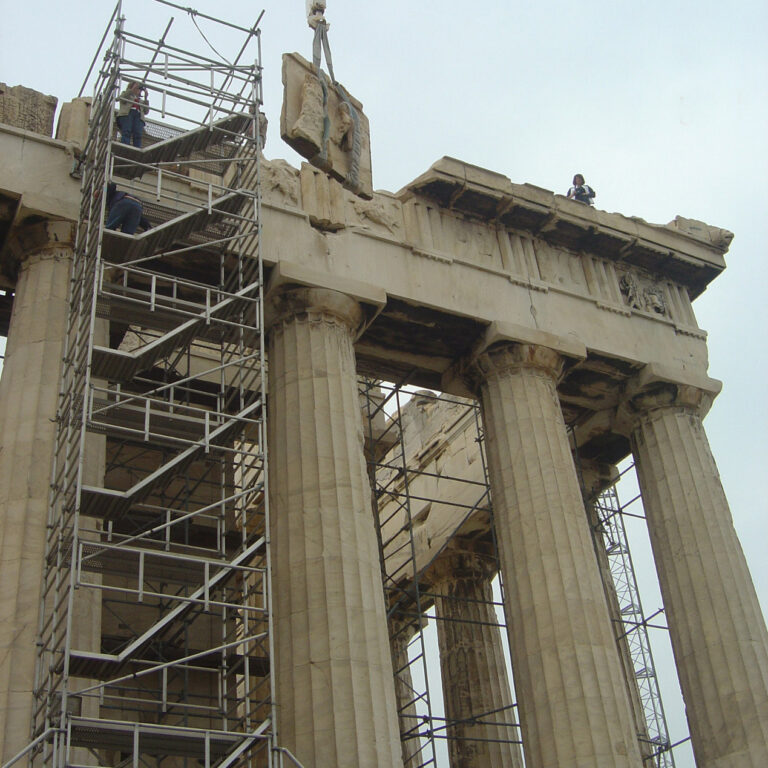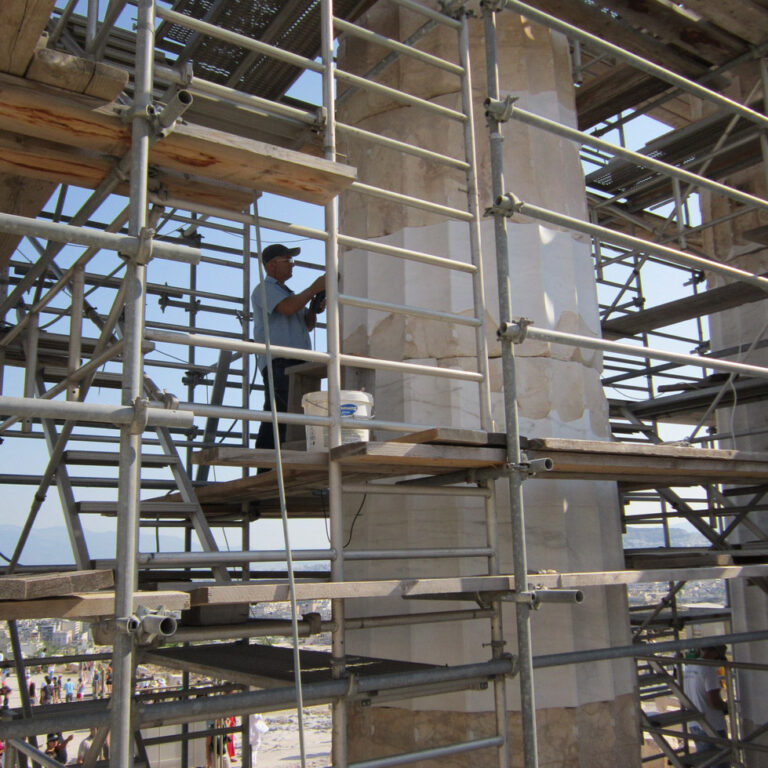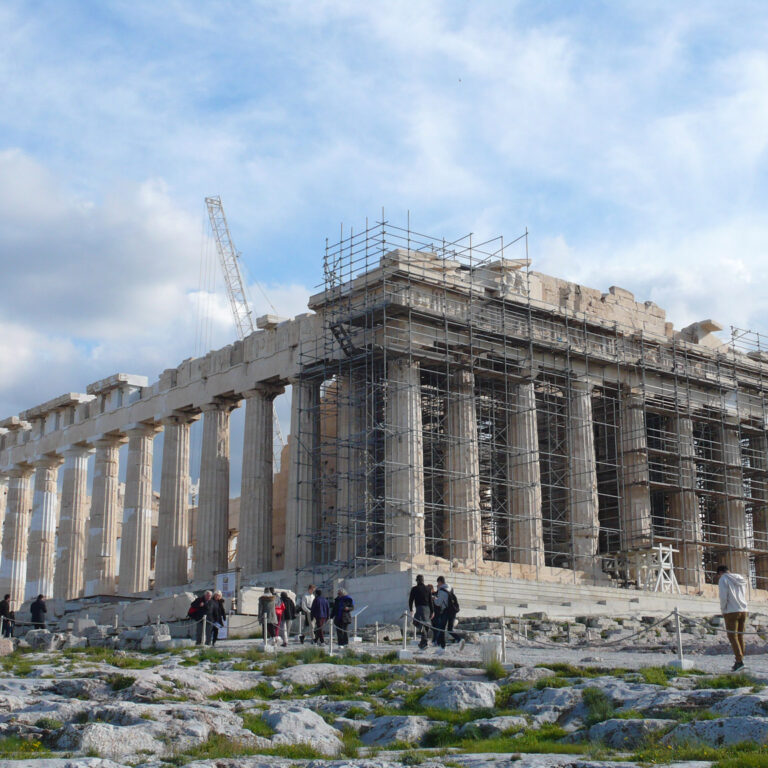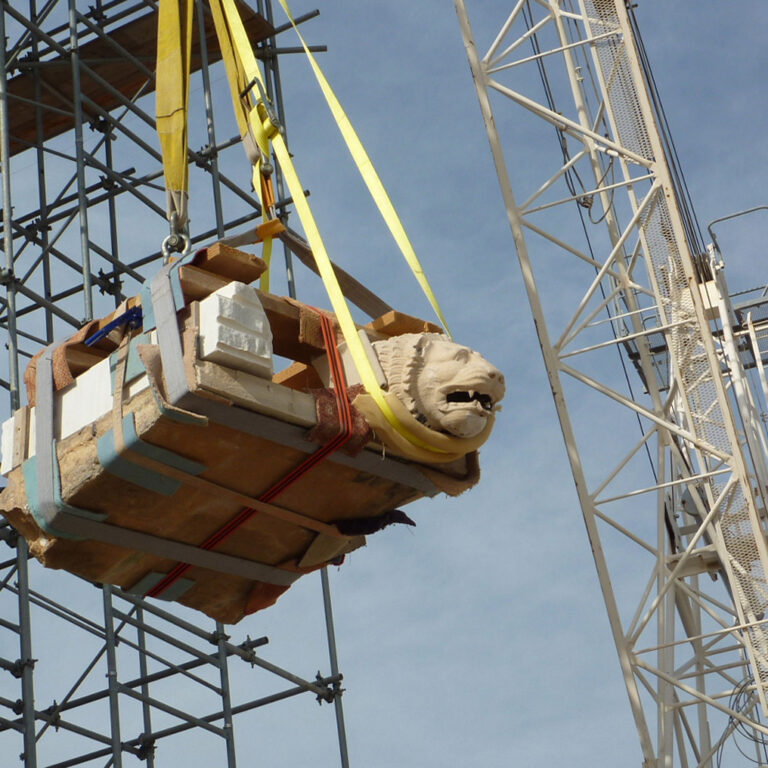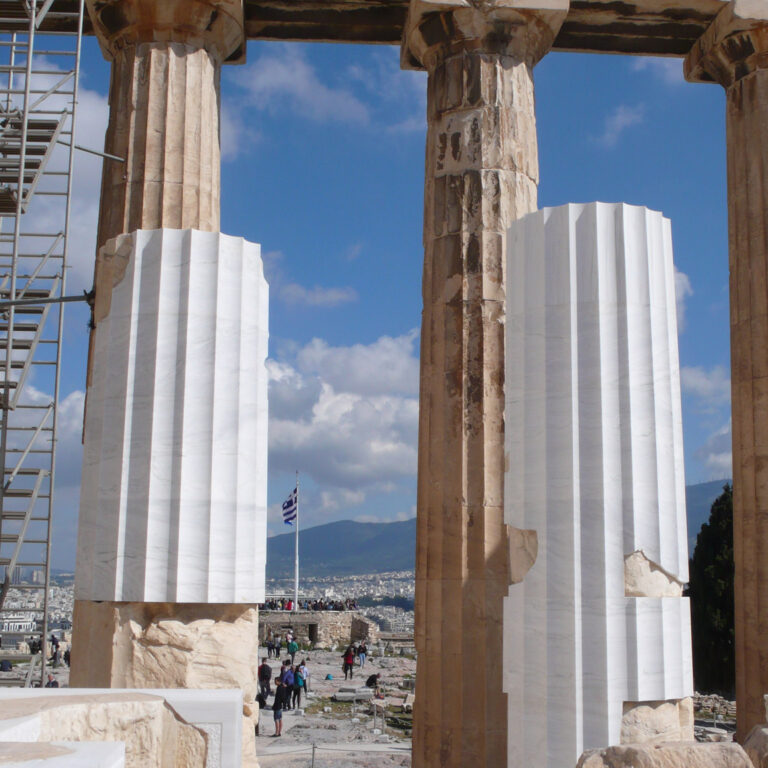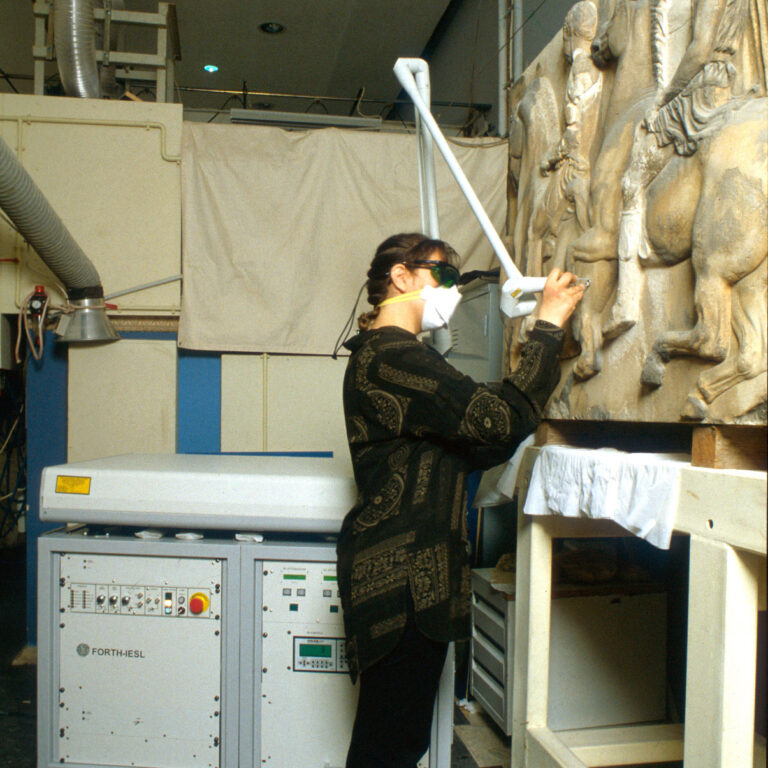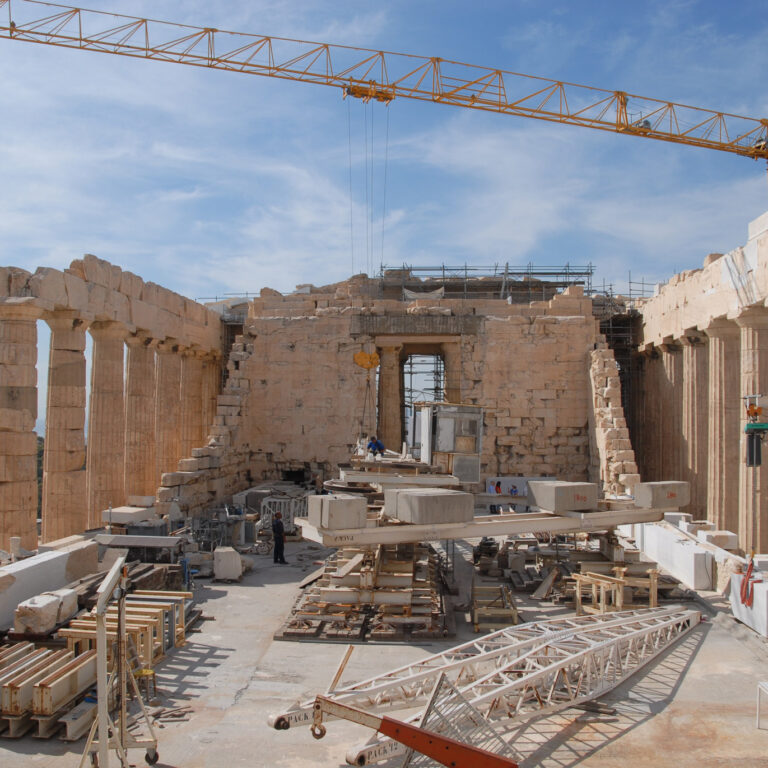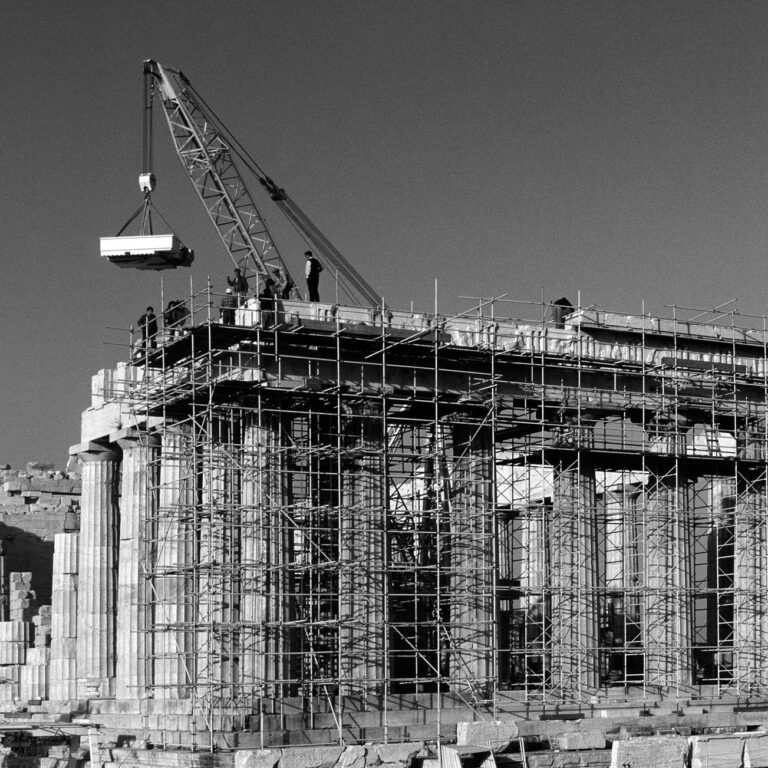
Restoration of the east side of the monument, which had suffered very serious damage because of the earthquake of 1981, was carried out between 1984 and 1991. The proposal, based on the study by M. Korres, was to dismantle the corners of the pediment and the corresponding entablature. In the course of the work, however, previously invisible breaks in the architectural members were discovered, which led to the extension of the works to include the entire pediment together with the horizontal cornice, the Doric frieze and the capital and uppermost drum of the 7th from the north column. The intervention was extended also to include the first metopes of the north side and the underlying cornice. Removal of the architectural members was followed by their structural restoration and they were then reset in their original positions. It was decided that it was necessary to replace the original metopes with copies in artificial stone.
In February 1992 work began on the restoration of the 5th column from the east in the south colonnade. The column had been damaged during the explosion of 1687, with the result that it had shifted and was inclined toward the south. Since the problem lay in the first drum, the column from the second drum up had to be removed as a whole, so that the continuity of the intermediate drums would be undisturbed. The intervention was carried out using an improvised mechanism for clasping and transporting that was designed by M. Korres and K. Zambas. The column was moved all in one piece and placed temporarily in the interior of the temple, while the first drum was being restored. The intervention was completed in July 1993.
Restoration of the pronaos of the Parthenon was carried out between the years 1995 and 2004, on the basis of the approved study of M. Korres. The proposal was for partial restoration of the first three columns from the north and the complete restoration of the fourth and fifth columns. Structural restoration was carried out on the members of the second, third, fourth and fifth columns from the north and on the preserved architrave blocks of the 4th and 5th intercolumniations. The sixth from the north column was dismantled down to the level of the second drum and was completely reassembled after its members were structurally restored. Relevant studies were carried out by the civil engineer M. Mentzini. Structural restoration were carried out by the civil engineers K. Zamba and M. Mentzini. All the new supplements were given an artificial patina so as to lessen the contrast between ancient and new marble. It remains to carve the fluting of the new marble pieces in the columns and to reset the architrave between the porch and the SE anta.
The programme for restoring the opisthonaos began in 1992, on the basis of the relevant study by P. Kouphopoulos, who was in addition the technical advisor for the work. The programme was implemented in two stages and completed in 2004. While the work proceeded, supplementary implementation studies were made by the architect P. Christodoulopoulou and studies for the structural restoration of the architectural members were made by the civil engineer E. Toumbakari. The first phase of the programme comprised the dismantling of the roof beams of the colonnade, the crown blocks of the west porch, and the west frieze blocks, which were taken to the Acropolis Museum in 1993. The second phase of the programme began in 2001 with the dismantling of the remaining members of the entablature of the west porch, a number of column capitals and top column drums. After all the members had been restored and some had been reassembled from ancient fragments, they were reset in the summer of 2004. The blocks of the west frieze that had been removed from the monument were replaced by copies cast in artificial stone. Consolidation of those columns that had never been dismantled in the past was carried out in situ, with special injections, in order to retain their authentic structure intact. This was done on the basis of the study by the civil engineer A. Miltiadou.
The restoration of the north colonnade of the temple began in October 2001. The approved study (initial study by K. Zambas, definitive study and implementation study by L. Lambrinou and R. Christodoulopoulou) stipulated the dismantling of eight columns (from the 4th to the 11th from the east) and the corresponding parts of the entablature above, the replacement of the concrete supplements of the previous intervention with supplements of new marble, the resetting in the monument of all identifiable ancient pieces, the replacement of existing clamps and dowels with corresponding ones of titanium and the anastelosis of the architectural members in their original positions so as to correct the earlier misplacements and transpositions. The structural restoration of the architectural members is being carried out on the basis of the relevant studies by the civil engineer M. Mentzini, and also by the engineers Ch. Kyparissi, E.E. Toumbakari and A. Vrouva. Much of this work has now been finished and the project is continuing at a good pace. In 2007 the programme was expanded to include the dismantling of the 7 ancient metopes that were still in situ and the conservation – restoration of the members of the west part of the entablature of the north peristyle (study by P. Chistodoulopoulou).
Completion of the intervention gave to the monument both structural strength and aesthetic wholeness, since the north side and the west side of the Parthenon together provide one of the most complete views of the temple, both for the visitor to the sacred rock and from most points of the city.
In the years between 2011-2014 works of carving the flutes in the new marble additions of six columns of the north colonnade (4th – 9th columns from the east) were completed. This is the final processing of the surface of the drums made of new marble and requires highly skilled craftsmanship.
Although the west side of the Parthenon represents the authenticity of the ancient construction, it presents various problems due to natural and anthropogenic causes. The works of restoration that began in 2011 aimed to address the serious structural problems and deformations of this part of the monument and to facilitate the structural restoration of most architectural parts and their supplement with new marble on several occasions, for reasons of structural adequacy.
The works were divided in 8 sub-programmes, of which the programs of restoration of the two corners of the entablature of the west side were judged urgent and were conducted between the years 2011-2015 (architectural study by V. Eleftheriou and V. Manidaki, structural study by A. Vrouva). Since 2011, a total of 117 architectural blocks have been dismantled, restored and reset on the monument. The main concern was the removal of the corroded iron clamps and the strengthening of architectural blocks through titanium rods. During the same time, from the two corners of the monument, a total of seven metopes were dismantled and transported to the Acropolis Museum for their display and protection. Accurate copies in artificial stone have already been placed on the monument as their replacement. New cast copies of two pedimental sculptures were also produced. The benefits gained by the conducted intervention – apart from the removal of the corroded iron clamp elements – was the elimination of distortions to a considerable extent and the reinforcement of the intervention area to make it earthquake resistant.
In addition, restoration work commenced on the door lintel of the west wall of the cella that had been constructed by N. Balanos of reinforced concrete (study by L. Lambrinou and V. Papavasileiou, which is an update of an earlier study prepared by M. Korres). From 2011 to 2015, structural restoration work was carried out on two of the four beams that comprised the lintel, which were filled with new marble. The next stage involves the dismantling of stones of the upper part of the wall in order to remove the heavy reinforced concrete structure and replace it with beams, one of which will be made entirely of marble.
Finaly, in 2016-2017, after examining the matter of the worksite infrastructure of the Parthenon, it was decided to transfer the Potain crane inside the monument. That crane, placed on the monument in 2002, has primarily assisted the works of restoring the north side of the monument and later on its west side. At the same time, it was also necessary to remove the Derrick crane, situated in the cella since 1983, because of its recurrent and unexpected failures. It was decided not to destroy this particular crane but to transfer it to Lavrio in December 2017 and place it in the NTUA technological park, where it will be exhibited as the most important machinery of the Parthenon restoration for over thirty years. According to the study of R. Christodoulopoulou and V. Manidaki the crane has to move on rails in order to accommodate all kinds of work, even the most demanding cases of lifting heavy loads, while its sub-base extends to the west wall of the cella. The removal of the cranes necessitated, in addition to moving a large number of architectural members so that they could be found within their range, the dismantling and removal of worksite constructions that had been built on the west part of the cella.
Conservation of the Parthenon
The condition of the architectural members of the Parthenon is due to a combination of historical events, the most important of which are considered to be the fire of 287 B.C., vandalism and the explosion of 1687. In more recent historical times, unsuccessful interventions of conservation and restoration, extensive atmospheric pollution, mainly from 1950 on, have deteriorated the monument’s condition. The state of preservation of most of the monument’s architectural members is characterized by various sorts of damage, disintegration and flaking, thermal expansion and sulphation, biodeterioration, fractures, cracks and delaminations, extensive pointing with Meyer cement. The first pilot project of systematic interventions carried out in 1988 and was focused on the second column from the north in the east end of the temple. Following that, the conservation programme of the monument was planned and developed in coordination with the broader restoration programme.
The interventions are focused on the following:
- East Side: the systematic conservation on the members of the entablature and on the columns is completed.
- Opisthonaos: preventive conservation work was carried out while the entablature was being dismantled. This was followed by systematic conservation of the columns and the dismantled members. This work was finished in 2005.
- West Frieze: Preventive conservation work was accomplished during the dismantling. This was followed by systematic conservation, and cleaning of the frieze blocks. This work was completed in 2005.
- Pronaos: Preventive interventions were carried out during the dismantling and resetting of the columns and architrave blocks. In addition, systematic conservation was conducted on the sixth from the north column. After the work was completed, an artificial patina was applied on the supplements of new marble.
- North Side: Preventive interventions were carried out on the entablature and the columns during their dismantling. Likewise members of the entablature and the seatings of the dismantled drums are being systematically conserved.
- North Metopes: Preventive conservation interventions were carried out.
Conservation of the west frieze
The west frieze is part of the Parthenon frieze that encircled the upper part of the cella walls and the columns of the pronaos and opisthonaos. It comprises 16 blocks, the first and second of which are in the British Museum. The frieze slabs have suffered mechanical stress and damage from the vandalisms, from the failure of previous interventions and from atmospheric pollution.
In 1978 the frieze was sheltered in an effort to avoid acidic attack on the sculptured surface and the washing out of the gypsum formed. The result of this choice was the covering of the surface of the slabs with deposits of soot and black incrustation. In 1992-93 the frieze blocks were dismantled and transferred to a specially constructed laboratory in the Acropolis Museum, so that their conservation could begin.
Conservation of the blocks began in 1999 and was successfully completed in 2005. Initially the work was focused on structural restoration of the blocks, in the course of which fragments were joined, the surfaces were consolidated and the mortars and pins of earlier interventions were removed. The surface was then cleaned of soot deposits and the black incrustation. Following a comparative study of four cleaning methods (microblasting, absorptive poultices, gypsum inversion and laser), cleaning by laser proved to be the most effective in all cases of deposits and substrates (monochromatic surface layers and marble). The cleaning system was designed and developed by the Institute of Electronical Structure and Laser of the Technical and Research Foundation, Crete. This is the laser type Q-switched Nd: YAG. The prototype system can emit both at two wave lengths (infrared 1064nm and ultraviolet 355nm), individually or simultaneously.
At the end, the joints were pointed in order to smooth out the surface discontinuities. The blocks of the west frieze are now on exhibition in the Acropolis Museum. Copies of artificial stone have been set in their place on the monument.
